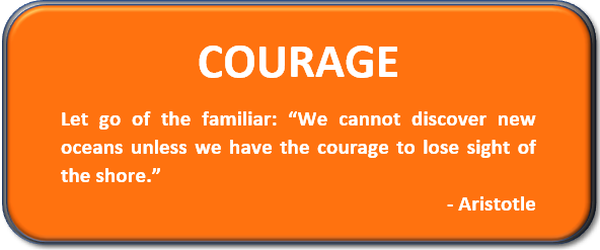Team courage is built by action. Sometimes action leads to progress, other times mistakes. In the right setting, mistakes are progress, too. That’s when courage is developed. The more courage is developed, the faster the action, the more real progress is made.
The leaders’ role is to provide the safety net so that people feel safe to say or do anything in front of anyone. Without repercussions. That’s psychological safety – the leaders’ role. Grab it by following these principles:
- Focus on learning, not executing
If your team misses the mark on a project, take the time to understand what went wrong instead of rushing to find the solution and moving onto the next task. Position mistakes as opportunities to learn and problem solve together. Your employees probably know what went wrong in the process, planning, execution, or between team members, so give them the space to discuss it openly without shame or other consequences.
- Encourage experimentation
A big part of learning and innovating is trying new things and challenging yourself (individually and in teams). Encourage experimentation and support the exploration of ideas instead of following previously-formed paths from A to B. If you want change, whether outside-the-box innovation or kaizen-like continuous improvement, be prepared to speak in “what-ifs”, not certainties. This lessens the blow of failure and therefore makes it easier to share more “risky” ideas.
- Demonstrate curiosity
Lead by example and ask a lot of questions. Not only will this spark discussions and demonstrate the value of changing the status quo, you’re showing that your workplace is a safe environment to be vulnerable and not know everything. Even managers have plenty to learn, so let employees see that!
On that note, by admitting and owning your own mistakes, you’re telling the team it’s ok to fail. Let your team know that you miss things or make mistakes, and that you expect them to speak up and hold you accountable, rather than keep quiet. You’re not the “boss,” you’re all in it together as one team.
- Embrace discomfort
We’ve all felt the anxiety leading up to a difficult conversation. However, if you set a standard that you and your team openly discuss issues and deal with them head on, you’ll prevent smaller issues from going unsaid and spiraling into real problems. By creating a safe environment to confront tough topics, you’ll work through issues together and come out stronger.
- Provide a Safety net
Creating a safe workplace takes more than an afternoon workshop. It’s demonstrated every day. Encourage everyone to talk up in meetings. Encourage everyone to share ideas. Encourage everyone to try new things. Just be ready to catch people when they fall. We all do. We all mess up. Keep it light, recognize it wasn’t intentional. We’re all human, right?
- One size does not fit all
Whether or not the organization is largely psychologically safe, every team and every group has its own set of unwritten rules, standards and individuals. A technique that works for Group A won’t necessarily work for Group B, so be sure that you consider your team’s subculture. Don’t copy and paste one team’s methods to your own.
- Build team values
With that in mind, try creating a set of written norms for everyone to follow. Build a mission or value statement unique to your team, including the characteristics that your team will embrace and embody, and the values that you’ll all respect and hold each other accountable to.
Building your team’s courage means committing to develop a safe, open, and inclusive workplace. Courage is undoubtedly the key to tapping into your team’s full potential, enabling them to innovate, push their boundaries, and truly differentiate your company.




